BSc (Hons) Business Management: Employee Motivation Report Analysis
VerifiedAdded on 2022/12/01
|9
|2230
|172
Report
AI Summary
This report delves into the multifaceted concept of employee motivation, analyzing its significance in fostering individual performance within a business setting. It begins by defining motivation and differentiating between intrinsic and extrinsic forms, supported by relevant theories like Maslow's hierarchy of needs and Taylor's management theory. The report then identifies key motivational factors, including salary, promotion, and work environment, emphasizing their impact on employee engagement and productivity. It further explores both positive outcomes, such as financial independence and personal development, and negative aspects, such as stress and anxiety, associated with job roles. Finally, the report proposes practical strategies to mitigate negative factors, such as promoting healthy lifestyles, encouraging open communication, fostering positive relationships, and encouraging self-reflection. The conclusion underscores the crucial role of motivation in business success and highlights the importance of proactive strategies to optimize employee well-being and performance.
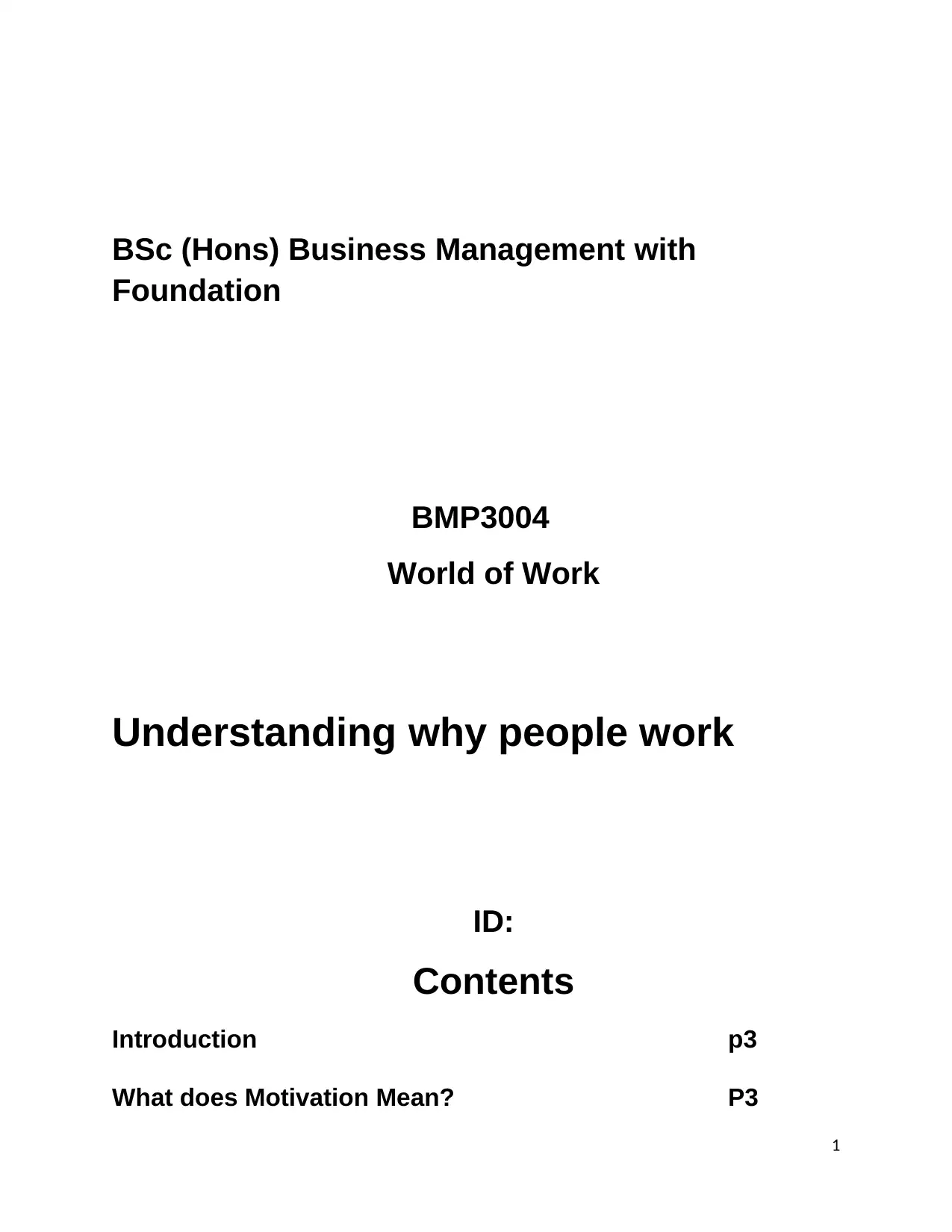
BSc (Hons) Business Management with
Foundation
BMP3004
World of Work
Understanding why people work
ID:
Contents
Introduction p3
What does Motivation Mean? P3
1
Foundation
BMP3004
World of Work
Understanding why people work
ID:
Contents
Introduction p3
What does Motivation Mean? P3
1
Paraphrase This Document
Need a fresh take? Get an instant paraphrase of this document with our AI Paraphraser
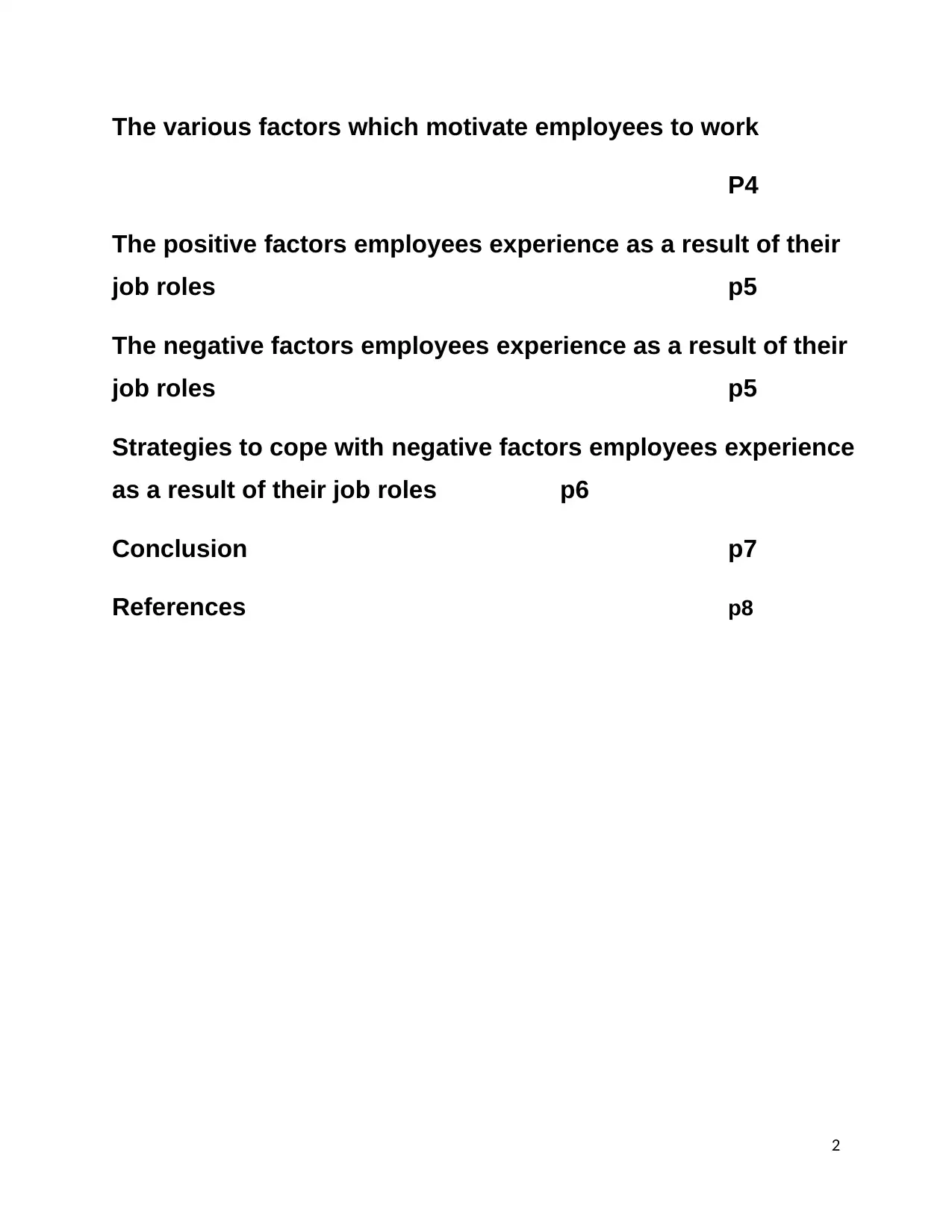
The various factors which motivate employees to work
P4
The positive factors employees experience as a result of their
job roles p5
The negative factors employees experience as a result of their
job roles p5
Strategies to cope with negative factors employees experience
as a result of their job roles p6
Conclusion p7
References p8
2
P4
The positive factors employees experience as a result of their
job roles p5
The negative factors employees experience as a result of their
job roles p5
Strategies to cope with negative factors employees experience
as a result of their job roles p6
Conclusion p7
References p8
2
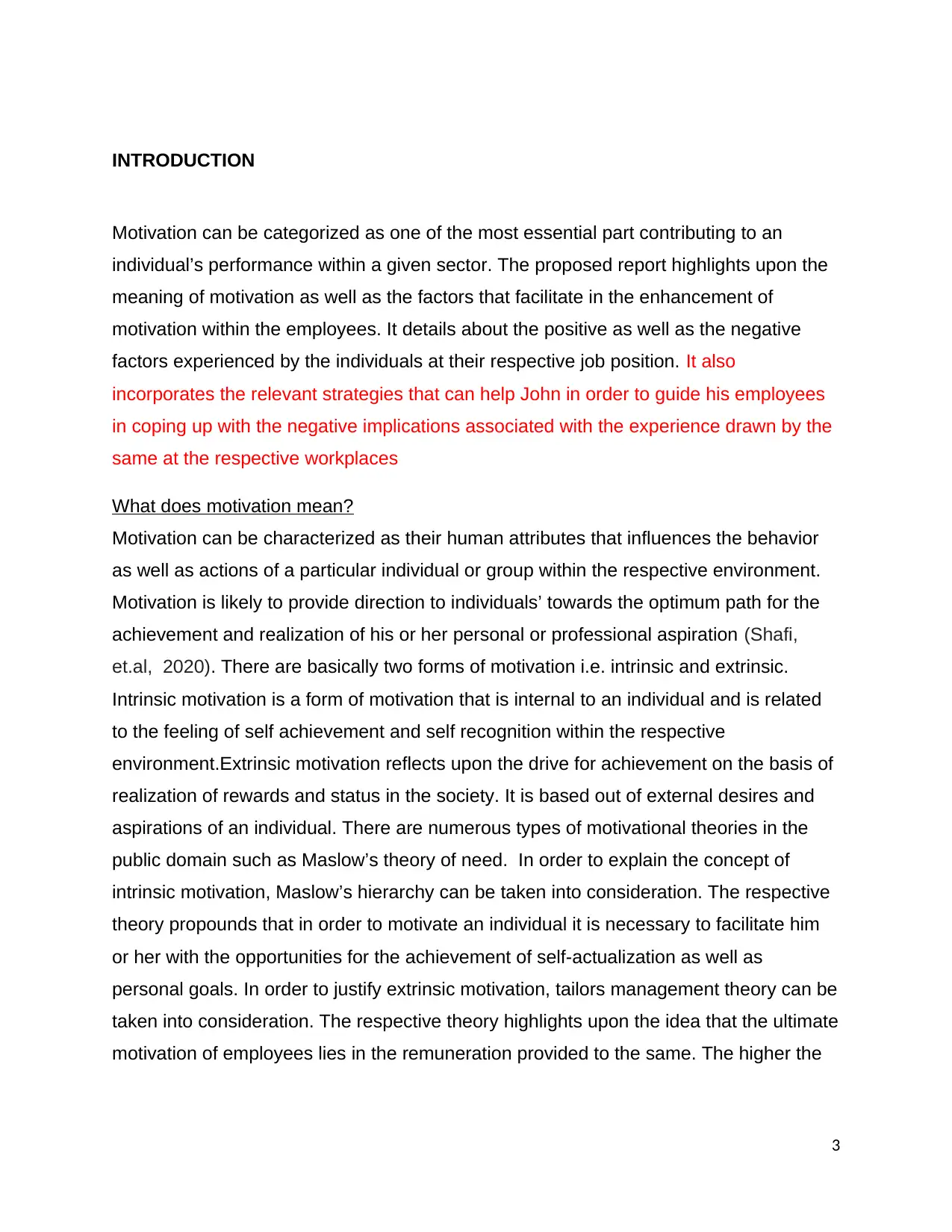
INTRODUCTION
Motivation can be categorized as one of the most essential part contributing to an
individual’s performance within a given sector. The proposed report highlights upon the
meaning of motivation as well as the factors that facilitate in the enhancement of
motivation within the employees. It details about the positive as well as the negative
factors experienced by the individuals at their respective job position. It also
incorporates the relevant strategies that can help John in order to guide his employees
in coping up with the negative implications associated with the experience drawn by the
same at the respective workplaces
What does motivation mean?
Motivation can be characterized as their human attributes that influences the behavior
as well as actions of a particular individual or group within the respective environment.
Motivation is likely to provide direction to individuals’ towards the optimum path for the
achievement and realization of his or her personal or professional aspiration (Shafi,
et.al, 2020). There are basically two forms of motivation i.e. intrinsic and extrinsic.
Intrinsic motivation is a form of motivation that is internal to an individual and is related
to the feeling of self achievement and self recognition within the respective
environment.Extrinsic motivation reflects upon the drive for achievement on the basis of
realization of rewards and status in the society. It is based out of external desires and
aspirations of an individual. There are numerous types of motivational theories in the
public domain such as Maslow’s theory of need. In order to explain the concept of
intrinsic motivation, Maslow’s hierarchy can be taken into consideration. The respective
theory propounds that in order to motivate an individual it is necessary to facilitate him
or her with the opportunities for the achievement of self-actualization as well as
personal goals. In order to justify extrinsic motivation, tailors management theory can be
taken into consideration. The respective theory highlights upon the idea that the ultimate
motivation of employees lies in the remuneration provided to the same. The higher the
3
Motivation can be categorized as one of the most essential part contributing to an
individual’s performance within a given sector. The proposed report highlights upon the
meaning of motivation as well as the factors that facilitate in the enhancement of
motivation within the employees. It details about the positive as well as the negative
factors experienced by the individuals at their respective job position. It also
incorporates the relevant strategies that can help John in order to guide his employees
in coping up with the negative implications associated with the experience drawn by the
same at the respective workplaces
What does motivation mean?
Motivation can be characterized as their human attributes that influences the behavior
as well as actions of a particular individual or group within the respective environment.
Motivation is likely to provide direction to individuals’ towards the optimum path for the
achievement and realization of his or her personal or professional aspiration (Shafi,
et.al, 2020). There are basically two forms of motivation i.e. intrinsic and extrinsic.
Intrinsic motivation is a form of motivation that is internal to an individual and is related
to the feeling of self achievement and self recognition within the respective
environment.Extrinsic motivation reflects upon the drive for achievement on the basis of
realization of rewards and status in the society. It is based out of external desires and
aspirations of an individual. There are numerous types of motivational theories in the
public domain such as Maslow’s theory of need. In order to explain the concept of
intrinsic motivation, Maslow’s hierarchy can be taken into consideration. The respective
theory propounds that in order to motivate an individual it is necessary to facilitate him
or her with the opportunities for the achievement of self-actualization as well as
personal goals. In order to justify extrinsic motivation, tailors management theory can be
taken into consideration. The respective theory highlights upon the idea that the ultimate
motivation of employees lies in the remuneration provided to the same. The higher the
3
⊘ This is a preview!⊘
Do you want full access?
Subscribe today to unlock all pages.

Trusted by 1+ million students worldwide
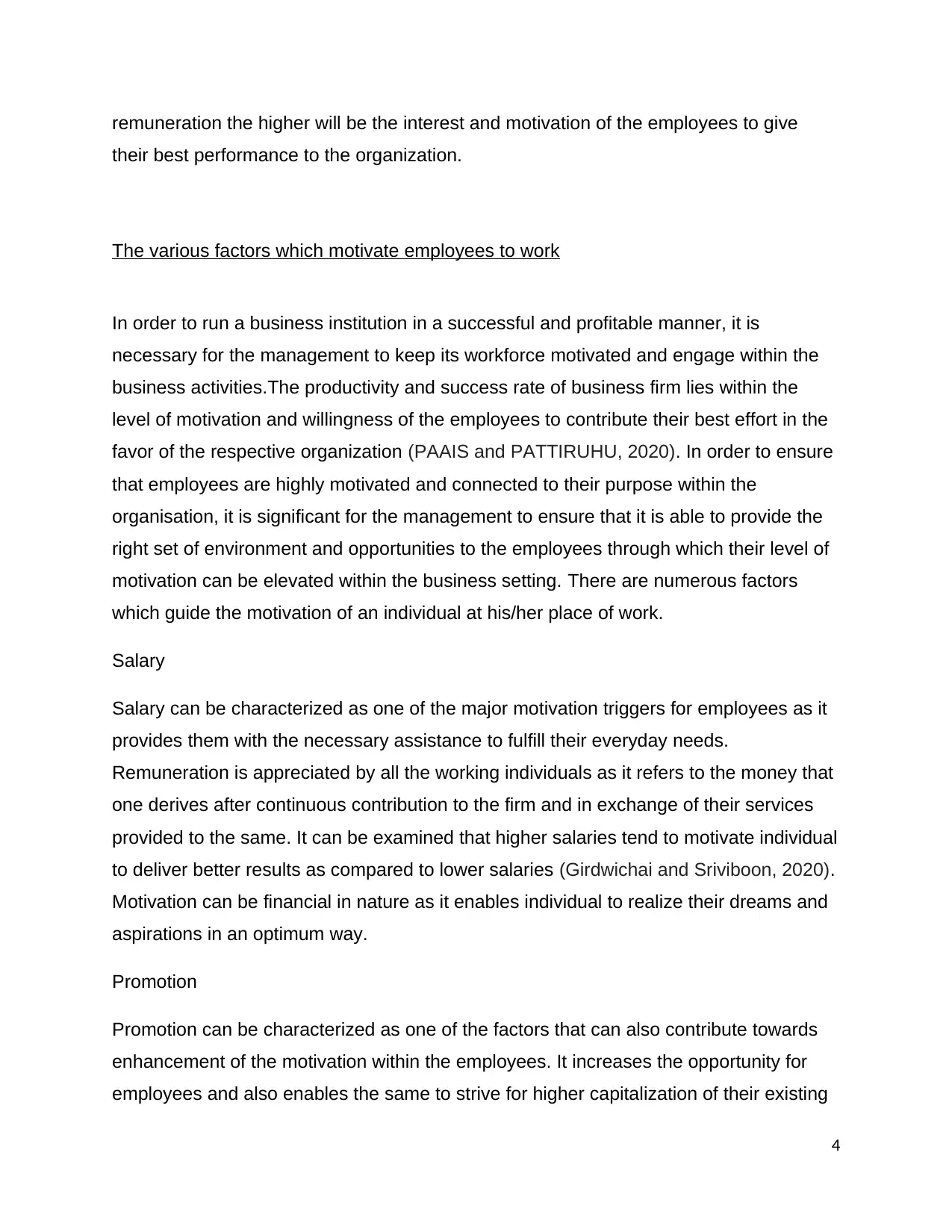
remuneration the higher will be the interest and motivation of the employees to give
their best performance to the organization.
The various factors which motivate employees to work
In order to run a business institution in a successful and profitable manner, it is
necessary for the management to keep its workforce motivated and engage within the
business activities.The productivity and success rate of business firm lies within the
level of motivation and willingness of the employees to contribute their best effort in the
favor of the respective organization (PAAIS and PATTIRUHU, 2020). In order to ensure
that employees are highly motivated and connected to their purpose within the
organisation, it is significant for the management to ensure that it is able to provide the
right set of environment and opportunities to the employees through which their level of
motivation can be elevated within the business setting. There are numerous factors
which guide the motivation of an individual at his/her place of work.
Salary
Salary can be characterized as one of the major motivation triggers for employees as it
provides them with the necessary assistance to fulfill their everyday needs.
Remuneration is appreciated by all the working individuals as it refers to the money that
one derives after continuous contribution to the firm and in exchange of their services
provided to the same. It can be examined that higher salaries tend to motivate individual
to deliver better results as compared to lower salaries (Girdwichai and Sriviboon, 2020).
Motivation can be financial in nature as it enables individual to realize their dreams and
aspirations in an optimum way.
Promotion
Promotion can be characterized as one of the factors that can also contribute towards
enhancement of the motivation within the employees. It increases the opportunity for
employees and also enables the same to strive for higher capitalization of their existing
4
their best performance to the organization.
The various factors which motivate employees to work
In order to run a business institution in a successful and profitable manner, it is
necessary for the management to keep its workforce motivated and engage within the
business activities.The productivity and success rate of business firm lies within the
level of motivation and willingness of the employees to contribute their best effort in the
favor of the respective organization (PAAIS and PATTIRUHU, 2020). In order to ensure
that employees are highly motivated and connected to their purpose within the
organisation, it is significant for the management to ensure that it is able to provide the
right set of environment and opportunities to the employees through which their level of
motivation can be elevated within the business setting. There are numerous factors
which guide the motivation of an individual at his/her place of work.
Salary
Salary can be characterized as one of the major motivation triggers for employees as it
provides them with the necessary assistance to fulfill their everyday needs.
Remuneration is appreciated by all the working individuals as it refers to the money that
one derives after continuous contribution to the firm and in exchange of their services
provided to the same. It can be examined that higher salaries tend to motivate individual
to deliver better results as compared to lower salaries (Girdwichai and Sriviboon, 2020).
Motivation can be financial in nature as it enables individual to realize their dreams and
aspirations in an optimum way.
Promotion
Promotion can be characterized as one of the factors that can also contribute towards
enhancement of the motivation within the employees. It increases the opportunity for
employees and also enables the same to strive for higher capitalization of their existing
4
Paraphrase This Document
Need a fresh take? Get an instant paraphrase of this document with our AI Paraphraser
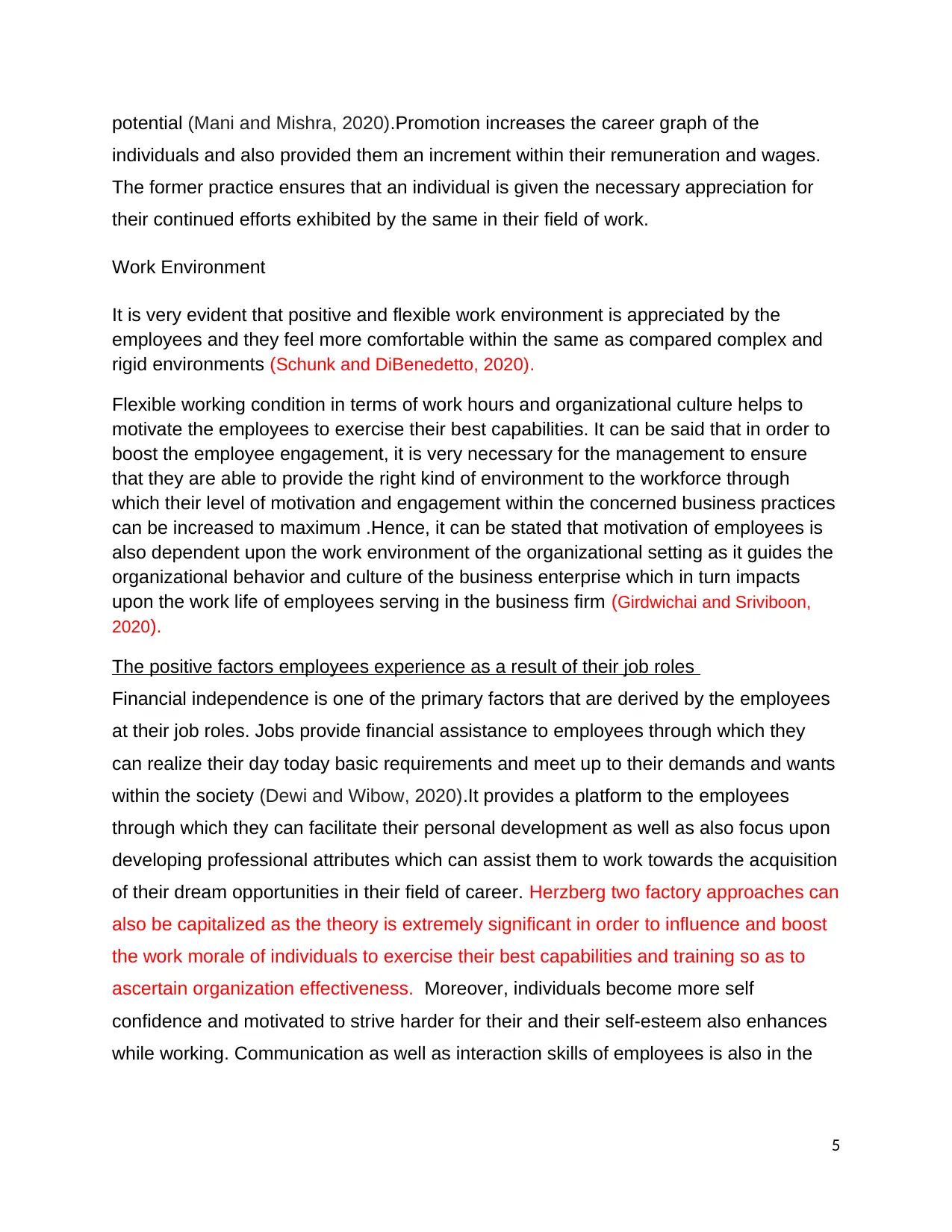
potential (Mani and Mishra, 2020).Promotion increases the career graph of the
individuals and also provided them an increment within their remuneration and wages.
The former practice ensures that an individual is given the necessary appreciation for
their continued efforts exhibited by the same in their field of work.
Work Environment
It is very evident that positive and flexible work environment is appreciated by the
employees and they feel more comfortable within the same as compared complex and
rigid environments (Schunk and DiBenedetto, 2020).
Flexible working condition in terms of work hours and organizational culture helps to
motivate the employees to exercise their best capabilities. It can be said that in order to
boost the employee engagement, it is very necessary for the management to ensure
that they are able to provide the right kind of environment to the workforce through
which their level of motivation and engagement within the concerned business practices
can be increased to maximum .Hence, it can be stated that motivation of employees is
also dependent upon the work environment of the organizational setting as it guides the
organizational behavior and culture of the business enterprise which in turn impacts
upon the work life of employees serving in the business firm (Girdwichai and Sriviboon,
2020).
The positive factors employees experience as a result of their job roles
Financial independence is one of the primary factors that are derived by the employees
at their job roles. Jobs provide financial assistance to employees through which they
can realize their day today basic requirements and meet up to their demands and wants
within the society (Dewi and Wibow, 2020).It provides a platform to the employees
through which they can facilitate their personal development as well as also focus upon
developing professional attributes which can assist them to work towards the acquisition
of their dream opportunities in their field of career. Herzberg two factory approaches can
also be capitalized as the theory is extremely significant in order to influence and boost
the work morale of individuals to exercise their best capabilities and training so as to
ascertain organization effectiveness. Moreover, individuals become more self
confidence and motivated to strive harder for their and their self-esteem also enhances
while working. Communication as well as interaction skills of employees is also in the
5
individuals and also provided them an increment within their remuneration and wages.
The former practice ensures that an individual is given the necessary appreciation for
their continued efforts exhibited by the same in their field of work.
Work Environment
It is very evident that positive and flexible work environment is appreciated by the
employees and they feel more comfortable within the same as compared complex and
rigid environments (Schunk and DiBenedetto, 2020).
Flexible working condition in terms of work hours and organizational culture helps to
motivate the employees to exercise their best capabilities. It can be said that in order to
boost the employee engagement, it is very necessary for the management to ensure
that they are able to provide the right kind of environment to the workforce through
which their level of motivation and engagement within the concerned business practices
can be increased to maximum .Hence, it can be stated that motivation of employees is
also dependent upon the work environment of the organizational setting as it guides the
organizational behavior and culture of the business enterprise which in turn impacts
upon the work life of employees serving in the business firm (Girdwichai and Sriviboon,
2020).
The positive factors employees experience as a result of their job roles
Financial independence is one of the primary factors that are derived by the employees
at their job roles. Jobs provide financial assistance to employees through which they
can realize their day today basic requirements and meet up to their demands and wants
within the society (Dewi and Wibow, 2020).It provides a platform to the employees
through which they can facilitate their personal development as well as also focus upon
developing professional attributes which can assist them to work towards the acquisition
of their dream opportunities in their field of career. Herzberg two factory approaches can
also be capitalized as the theory is extremely significant in order to influence and boost
the work morale of individuals to exercise their best capabilities and training so as to
ascertain organization effectiveness. Moreover, individuals become more self
confidence and motivated to strive harder for their and their self-esteem also enhances
while working. Communication as well as interaction skills of employees is also in the
5
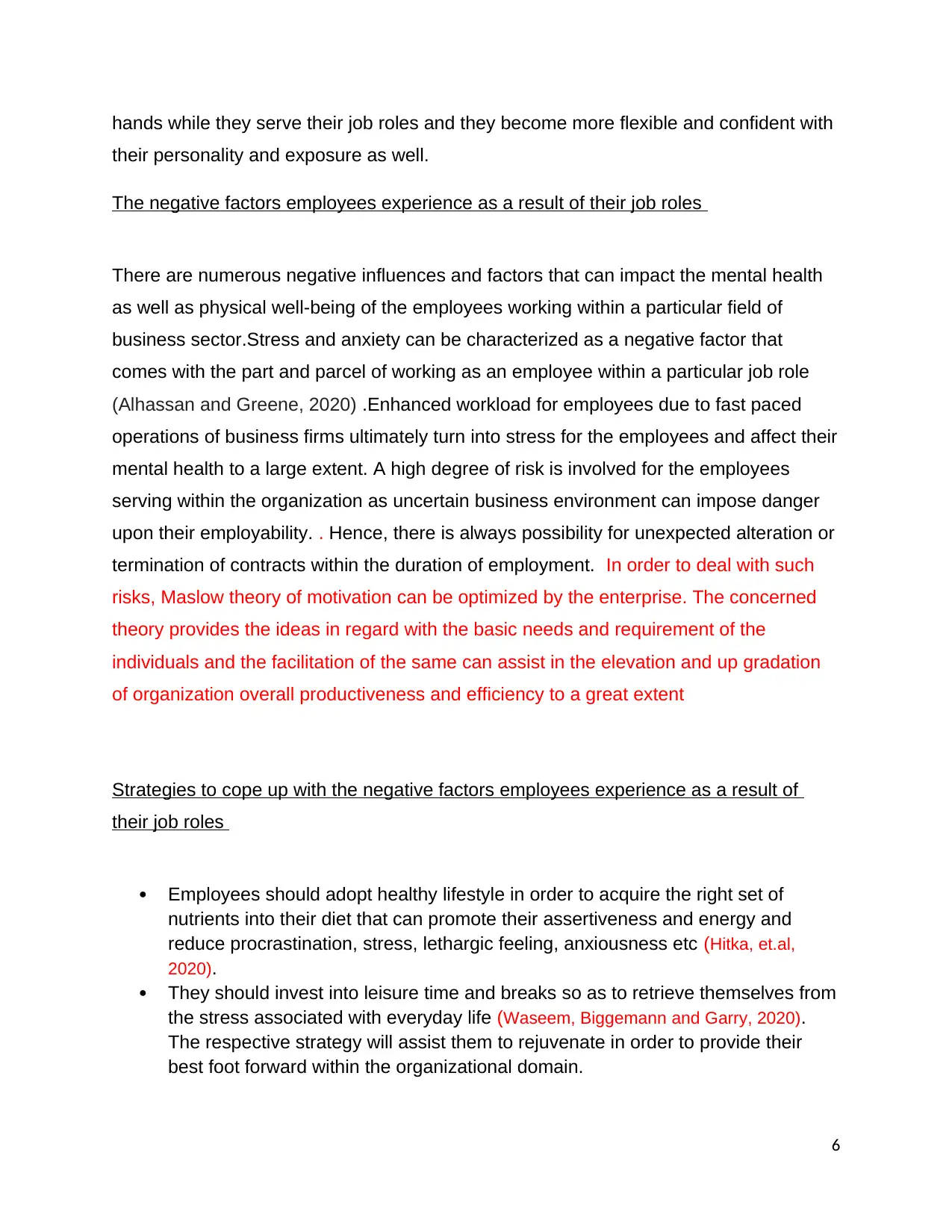
hands while they serve their job roles and they become more flexible and confident with
their personality and exposure as well.
The negative factors employees experience as a result of their job roles
There are numerous negative influences and factors that can impact the mental health
as well as physical well-being of the employees working within a particular field of
business sector.Stress and anxiety can be characterized as a negative factor that
comes with the part and parcel of working as an employee within a particular job role
(Alhassan and Greene, 2020) .Enhanced workload for employees due to fast paced
operations of business firms ultimately turn into stress for the employees and affect their
mental health to a large extent. A high degree of risk is involved for the employees
serving within the organization as uncertain business environment can impose danger
upon their employability. . Hence, there is always possibility for unexpected alteration or
termination of contracts within the duration of employment. In order to deal with such
risks, Maslow theory of motivation can be optimized by the enterprise. The concerned
theory provides the ideas in regard with the basic needs and requirement of the
individuals and the facilitation of the same can assist in the elevation and up gradation
of organization overall productiveness and efficiency to a great extent
Strategies to cope up with the negative factors employees experience as a result of
their job roles
Employees should adopt healthy lifestyle in order to acquire the right set of
nutrients into their diet that can promote their assertiveness and energy and
reduce procrastination, stress, lethargic feeling, anxiousness etc (Hitka, et.al,
2020).
They should invest into leisure time and breaks so as to retrieve themselves from
the stress associated with everyday life (Waseem, Biggemann and Garry, 2020).
The respective strategy will assist them to rejuvenate in order to provide their
best foot forward within the organizational domain.
6
their personality and exposure as well.
The negative factors employees experience as a result of their job roles
There are numerous negative influences and factors that can impact the mental health
as well as physical well-being of the employees working within a particular field of
business sector.Stress and anxiety can be characterized as a negative factor that
comes with the part and parcel of working as an employee within a particular job role
(Alhassan and Greene, 2020) .Enhanced workload for employees due to fast paced
operations of business firms ultimately turn into stress for the employees and affect their
mental health to a large extent. A high degree of risk is involved for the employees
serving within the organization as uncertain business environment can impose danger
upon their employability. . Hence, there is always possibility for unexpected alteration or
termination of contracts within the duration of employment. In order to deal with such
risks, Maslow theory of motivation can be optimized by the enterprise. The concerned
theory provides the ideas in regard with the basic needs and requirement of the
individuals and the facilitation of the same can assist in the elevation and up gradation
of organization overall productiveness and efficiency to a great extent
Strategies to cope up with the negative factors employees experience as a result of
their job roles
Employees should adopt healthy lifestyle in order to acquire the right set of
nutrients into their diet that can promote their assertiveness and energy and
reduce procrastination, stress, lethargic feeling, anxiousness etc (Hitka, et.al,
2020).
They should invest into leisure time and breaks so as to retrieve themselves from
the stress associated with everyday life (Waseem, Biggemann and Garry, 2020).
The respective strategy will assist them to rejuvenate in order to provide their
best foot forward within the organizational domain.
6
⊘ This is a preview!⊘
Do you want full access?
Subscribe today to unlock all pages.

Trusted by 1+ million students worldwide
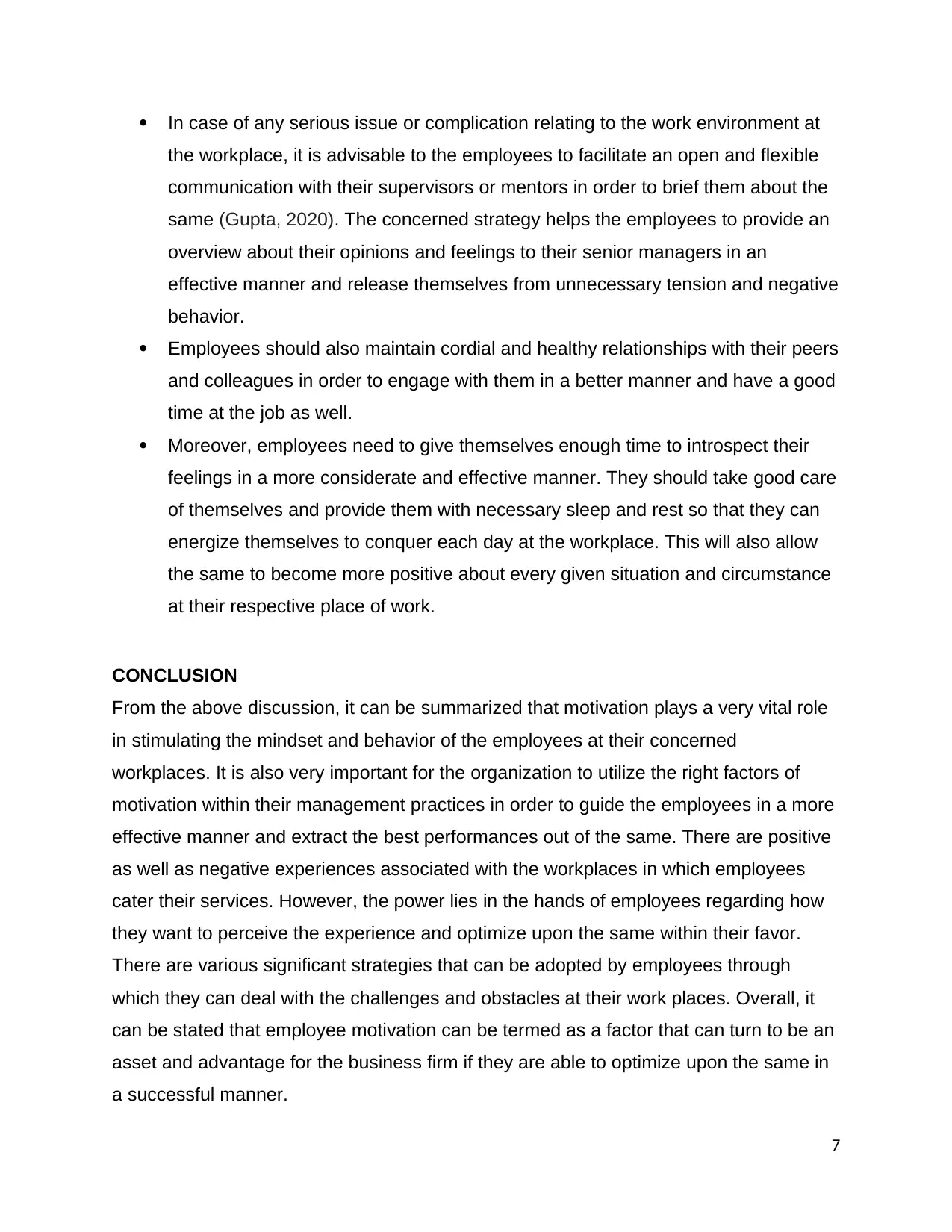
In case of any serious issue or complication relating to the work environment at
the workplace, it is advisable to the employees to facilitate an open and flexible
communication with their supervisors or mentors in order to brief them about the
same (Gupta, 2020). The concerned strategy helps the employees to provide an
overview about their opinions and feelings to their senior managers in an
effective manner and release themselves from unnecessary tension and negative
behavior.
Employees should also maintain cordial and healthy relationships with their peers
and colleagues in order to engage with them in a better manner and have a good
time at the job as well.
Moreover, employees need to give themselves enough time to introspect their
feelings in a more considerate and effective manner. They should take good care
of themselves and provide them with necessary sleep and rest so that they can
energize themselves to conquer each day at the workplace. This will also allow
the same to become more positive about every given situation and circumstance
at their respective place of work.
CONCLUSION
From the above discussion, it can be summarized that motivation plays a very vital role
in stimulating the mindset and behavior of the employees at their concerned
workplaces. It is also very important for the organization to utilize the right factors of
motivation within their management practices in order to guide the employees in a more
effective manner and extract the best performances out of the same. There are positive
as well as negative experiences associated with the workplaces in which employees
cater their services. However, the power lies in the hands of employees regarding how
they want to perceive the experience and optimize upon the same within their favor.
There are various significant strategies that can be adopted by employees through
which they can deal with the challenges and obstacles at their work places. Overall, it
can be stated that employee motivation can be termed as a factor that can turn to be an
asset and advantage for the business firm if they are able to optimize upon the same in
a successful manner.
7
the workplace, it is advisable to the employees to facilitate an open and flexible
communication with their supervisors or mentors in order to brief them about the
same (Gupta, 2020). The concerned strategy helps the employees to provide an
overview about their opinions and feelings to their senior managers in an
effective manner and release themselves from unnecessary tension and negative
behavior.
Employees should also maintain cordial and healthy relationships with their peers
and colleagues in order to engage with them in a better manner and have a good
time at the job as well.
Moreover, employees need to give themselves enough time to introspect their
feelings in a more considerate and effective manner. They should take good care
of themselves and provide them with necessary sleep and rest so that they can
energize themselves to conquer each day at the workplace. This will also allow
the same to become more positive about every given situation and circumstance
at their respective place of work.
CONCLUSION
From the above discussion, it can be summarized that motivation plays a very vital role
in stimulating the mindset and behavior of the employees at their concerned
workplaces. It is also very important for the organization to utilize the right factors of
motivation within their management practices in order to guide the employees in a more
effective manner and extract the best performances out of the same. There are positive
as well as negative experiences associated with the workplaces in which employees
cater their services. However, the power lies in the hands of employees regarding how
they want to perceive the experience and optimize upon the same within their favor.
There are various significant strategies that can be adopted by employees through
which they can deal with the challenges and obstacles at their work places. Overall, it
can be stated that employee motivation can be termed as a factor that can turn to be an
asset and advantage for the business firm if they are able to optimize upon the same in
a successful manner.
7
Paraphrase This Document
Need a fresh take? Get an instant paraphrase of this document with our AI Paraphraser

8
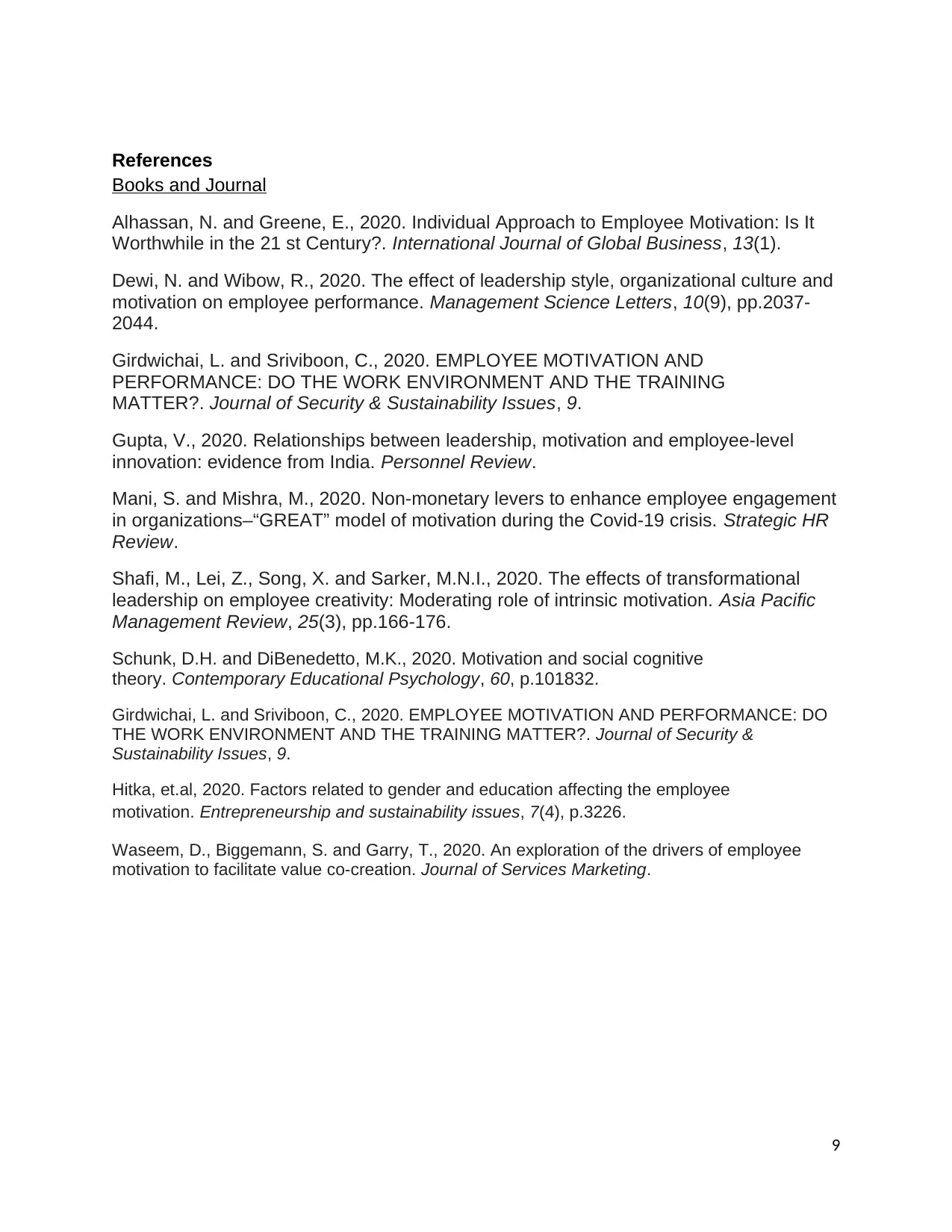
References
Books and Journal
Alhassan, N. and Greene, E., 2020. Individual Approach to Employee Motivation: Is It
Worthwhile in the 21 st Century?. International Journal of Global Business, 13(1).
Dewi, N. and Wibow, R., 2020. The effect of leadership style, organizational culture and
motivation on employee performance. Management Science Letters, 10(9), pp.2037-
2044.
Girdwichai, L. and Sriviboon, C., 2020. EMPLOYEE MOTIVATION AND
PERFORMANCE: DO THE WORK ENVIRONMENT AND THE TRAINING
MATTER?. Journal of Security & Sustainability Issues, 9.
Gupta, V., 2020. Relationships between leadership, motivation and employee-level
innovation: evidence from India. Personnel Review.
Mani, S. and Mishra, M., 2020. Non-monetary levers to enhance employee engagement
in organizations–“GREAT” model of motivation during the Covid-19 crisis. Strategic HR
Review.
Shafi, M., Lei, Z., Song, X. and Sarker, M.N.I., 2020. The effects of transformational
leadership on employee creativity: Moderating role of intrinsic motivation. Asia Pacific
Management Review, 25(3), pp.166-176.
Schunk, D.H. and DiBenedetto, M.K., 2020. Motivation and social cognitive
theory. Contemporary Educational Psychology, 60, p.101832.
Girdwichai, L. and Sriviboon, C., 2020. EMPLOYEE MOTIVATION AND PERFORMANCE: DO
THE WORK ENVIRONMENT AND THE TRAINING MATTER?. Journal of Security &
Sustainability Issues, 9.
Hitka, et.al, 2020. Factors related to gender and education affecting the employee
motivation. Entrepreneurship and sustainability issues, 7(4), p.3226.
Waseem, D., Biggemann, S. and Garry, T., 2020. An exploration of the drivers of employee
motivation to facilitate value co-creation. Journal of Services Marketing.
9
Books and Journal
Alhassan, N. and Greene, E., 2020. Individual Approach to Employee Motivation: Is It
Worthwhile in the 21 st Century?. International Journal of Global Business, 13(1).
Dewi, N. and Wibow, R., 2020. The effect of leadership style, organizational culture and
motivation on employee performance. Management Science Letters, 10(9), pp.2037-
2044.
Girdwichai, L. and Sriviboon, C., 2020. EMPLOYEE MOTIVATION AND
PERFORMANCE: DO THE WORK ENVIRONMENT AND THE TRAINING
MATTER?. Journal of Security & Sustainability Issues, 9.
Gupta, V., 2020. Relationships between leadership, motivation and employee-level
innovation: evidence from India. Personnel Review.
Mani, S. and Mishra, M., 2020. Non-monetary levers to enhance employee engagement
in organizations–“GREAT” model of motivation during the Covid-19 crisis. Strategic HR
Review.
Shafi, M., Lei, Z., Song, X. and Sarker, M.N.I., 2020. The effects of transformational
leadership on employee creativity: Moderating role of intrinsic motivation. Asia Pacific
Management Review, 25(3), pp.166-176.
Schunk, D.H. and DiBenedetto, M.K., 2020. Motivation and social cognitive
theory. Contemporary Educational Psychology, 60, p.101832.
Girdwichai, L. and Sriviboon, C., 2020. EMPLOYEE MOTIVATION AND PERFORMANCE: DO
THE WORK ENVIRONMENT AND THE TRAINING MATTER?. Journal of Security &
Sustainability Issues, 9.
Hitka, et.al, 2020. Factors related to gender and education affecting the employee
motivation. Entrepreneurship and sustainability issues, 7(4), p.3226.
Waseem, D., Biggemann, S. and Garry, T., 2020. An exploration of the drivers of employee
motivation to facilitate value co-creation. Journal of Services Marketing.
9
⊘ This is a preview!⊘
Do you want full access?
Subscribe today to unlock all pages.

Trusted by 1+ million students worldwide
1 out of 9
Related Documents
Your All-in-One AI-Powered Toolkit for Academic Success.
+13062052269
info@desklib.com
Available 24*7 on WhatsApp / Email
![[object Object]](/_next/static/media/star-bottom.7253800d.svg)
Unlock your academic potential
Copyright © 2020–2025 A2Z Services. All Rights Reserved. Developed and managed by ZUCOL.



